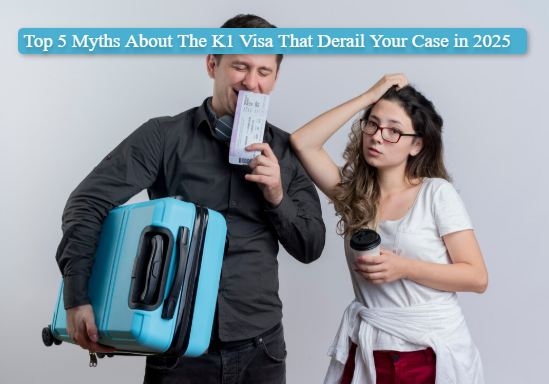The Top 5 Myths About K-1 Visas That Could Ruin Your Application
At Passage Immigration Law, we’ve met so many couples with big dreams, wedding plans, travel arrangements, and new jobs waiting only to have those dreams delayed or even derailed because of misinformation about the K1 fiancé visa.
The K1 visa is one of the most misunderstood visas in the U.S. immigration system. Myths spread quickly online, and unfortunately, following the wrong advice can cost you precious time, money, and the chance to live together in the United States.
Today, we’re breaking down the top five myths about the K1 Visa, showing you the truth behind each, and giving you the practical steps to avoid mistakes.
Why These Myths Stick
- The requirements look simple until you read the fine print.
- Processing times changes and embassies work at different speeds, so fiancée visa processing time varies.
- Old advice gets repeated even when it no longer applies.
- Couples plan around weddings and jobs, then try to make the visa fit their plan.
Our goal is to flip that. First, learn the requirements. Then build a plan that fits your life.
Myth 1: K1 Is Always the Fastest and Cheapest

This feels true because the first step looks straightforward: File a petition, get an interview, fly, then marry. In reality, this path takes more steps and time.
What really happens
- There are several waiting periods. USCIS, then NVC, then the U.S. embassy, then the flight, then marriage, then Adjustment of Status after you arrive.
- Each step takes time. Your K1 visa processing time depends on your service centre and your consulate’s interview calendar, which shapes how long a fiancée visa processing time takes end-to-end. Typically, it takes 10 to 16 months from start to finish, but this varies with every case.
- Adjustment of Status. After the wedding, you can file for a green card inside the United States. That means additional forms and processing time.
When K1 makes sense
- You need to be together in the United States first, and are fine with the green card step coming later.
- Your embassy has steady interview availability.
- You want to marry in the USA.
- You can handle months without work or travel right after the wedding.
When to compare spousal options
- If your top priority is arriving with immediate work and travel rights.
- If your embassy has long K category backlogs.
Takeaway
Do not assume faster or cheaper. Map the full journey on paper before you choose, and check how long the fiancée visa processing time is for your location.
Myth 2: You Can Work Right Away
A common question we hear is, “Can you work with a K1 visa status right away?” The answer is no.
What really happens
- The K1 itself does not permit you to work right away.
- You need a K1 visa work permit from USCIS. Some couples try a temporary K1-based work card that ends after the 90-day window. In practice, this is often too short to be useful.
- Most couples marry, then file the green card packet with an application for a proper work authorization card.
Planning moves that help
- Set a short-term budget for the no-work period.
- Keep proof of your last day of work abroad in case an employer asks for records later.
- Apply for the work card together with your green card forms.
Takeaway
Expect a waiting period before you can start work. Start planning for it now so you aren’t caught off guard you later.
Myth 3: You Can Fly Home And Come Back Anytime
It is natural to think you can visit family after you arrive and return for the wedding day. The K1 does not work that way.
What really happens
- The K1 is an entry permit. You use it once to enter. That is it.
- If you leave the United States before getting travel permission in the green card stage, you could forfeit you case.
What to do instead
- Plan big family events either before you enter or after you have travel permission as part of the green card process.
- Keep relatives updated so they do not book tickets that force or pressure you into risky travel.
Takeaway
Do not leave the country until you have proper travel permission through your pending green card case.
Myth 4: Online Proof Alone Is Enough

Messages and video calls can illustrate real love, but they are not the whole picture. To meet the requirements you must have evidence of in-person contact.
What really happens
- You must have met each other in person at least once in the two years before filing, unless you qualify for a very narrow waiver under the basic requirements for K1 visa filings.
Proof of relationship documents that work
- Boarding passes, passport stamps, and hotel receipts tied to dates.
- Photos with clear labels showing place and time.
- Statements showing you plan to marry within 90 days of arrival, such as a venue inquiry, simple deposit, or a city hall appointment hold.
- Ongoing chat logs in a short index, not a thousand pages of messages. Quality beats volume.
If you cannot meet
- A waiver is hard to get. It requires strong reasons such as long-standing cultural rules or serious hardship.
- Speak with a lawyer before you file. Most couples are better off planning a short visit to meet the requirements and gather clean proof of relationship documents.
Takeaway
Build a clear, simple evidence story. Show when you met, how the relationship grew, and how you will marry within the 90-day window.
Myth 5: You Can Fix It Later If You Miss The 90 Days
This one causes the most pain. Some couples think they can marry after 90 days and explain or justify it during the interview. Others believe they can pivot and marry a different person and stay. Neither of these are viable options.
What really happens
- You must marry the original petitioner within 90 days of your entry.
- If you miss the deadline, you cannot continue.
- If you marry a different person, you need a new petition. You may also need to leave and process abroad.
How to stay safe
- Put the I-94 date in your phone the day you land.
- Pick a marriage plan that is simple and fast to schedule if the consulate delivers the visa later than expected.
- File your I-485 before falling out of status.
Takeaway
Protect the 90-day rule. Build your wedding plan around it, not the other way around.
What The Full K1 Journey Looks Like (K1 Visa Step by Step)

Here is a simple outline you can print and stick on the fridge.
Petition
File Form I-129F with a clear packet that shows your in-person meeting and intent to marry within 90 days using organized K1 visa documents.
Case number and transfer
After approval, your case moves to the National Visa Centre. Prepare civil documents early so you do not lose time here, and watch your K-1 visa processing time at each stage.
Embassy steps
Complete the online form, the medical exam, and your document upload. Book the interview when the calendar opens. Watch your email and the K1 visa approval time guidance for your location.
Visa in passport
Check the visa details and the entry validity dates. Book travel that gives you a few extra days of buffer.
Arrival and marriage
Land, settle in, and get married within the 90-day window.
Green card stage
File Adjustment of Status with your work authorization card and travel applications bundled together to save time.
Small Habits That Make A Big Difference
- Keep a master folder with a one-page index. Officers love clean packets.
- Label every photo and receipt with the date and place as part of your “proof of relationship” file.
- Track your K1 visa processing time and your embassy’s interview wait page monthly. Adjust plans, do not guess.
- Keep two copies of everything. One to submit. One to bring to the interview.
- Decide early if you need legal help. A short strategy call can save months later.
When To Ask For Help
- You have a prior visa denial or removal issue.
- There are criminal records or past protection orders.
- You need a waiver, or your culture restricts in-person meetings, and you must gather fiancée visa required documents carefully.
- Your child will turn 21 soon, and timing is tight.
- You must plan around medical issues or urgent family events.
Pro Tip: If marriage abroad is possible, you should consider filing an I-130/I-129F (K-3) combo. First, the I-129F is free if filed in conjunction with an I-130 AND whichever one gets approved FIRST is the one that will get you into the USA the fastest. This will be the pathway to your green card.
K-3 visas are good for 2 years. A person admitted to the United States with a K-3 or K-4 visa is automatically authorized to work. You can file Form I-765 obtain a physical Employment Authorization Document (EAD) as evidence of that authorization for employers.
If you want steady guidance and clear checklists, our team at Passage Immigration Law can map your full timeline, clean up your evidence, and prepare you for the interview. Book a consultation with us and see how we will outline your timeline, build your document list, and keep each step moving until you are together.
Disclaimer: This article offers general legal information, not legal advice. Do not rely upon this information without seeking legal counsel. If you need legal advice, you may contact us directly to speak with an attorney. We disclaim all liability with respect to actions taken based on any information presented. Every case is different, and outcomes will vary depending on the unique facts and legal issues of your case.







